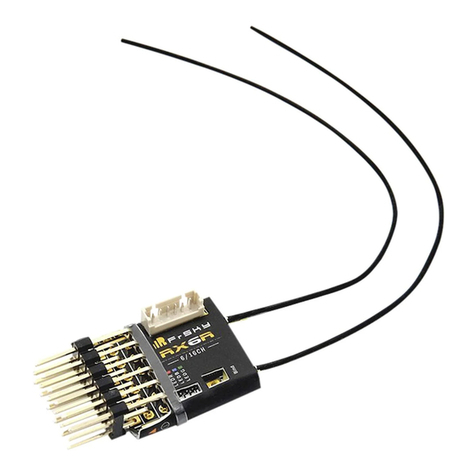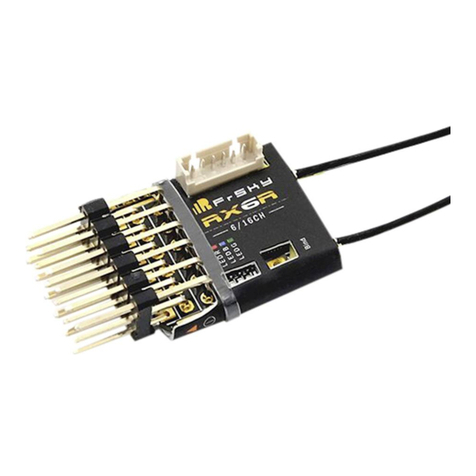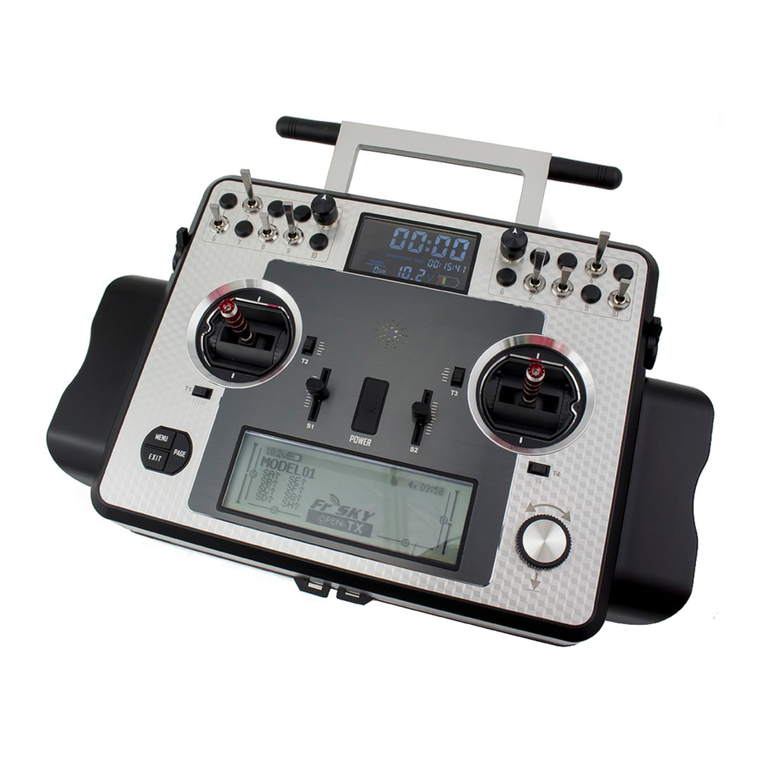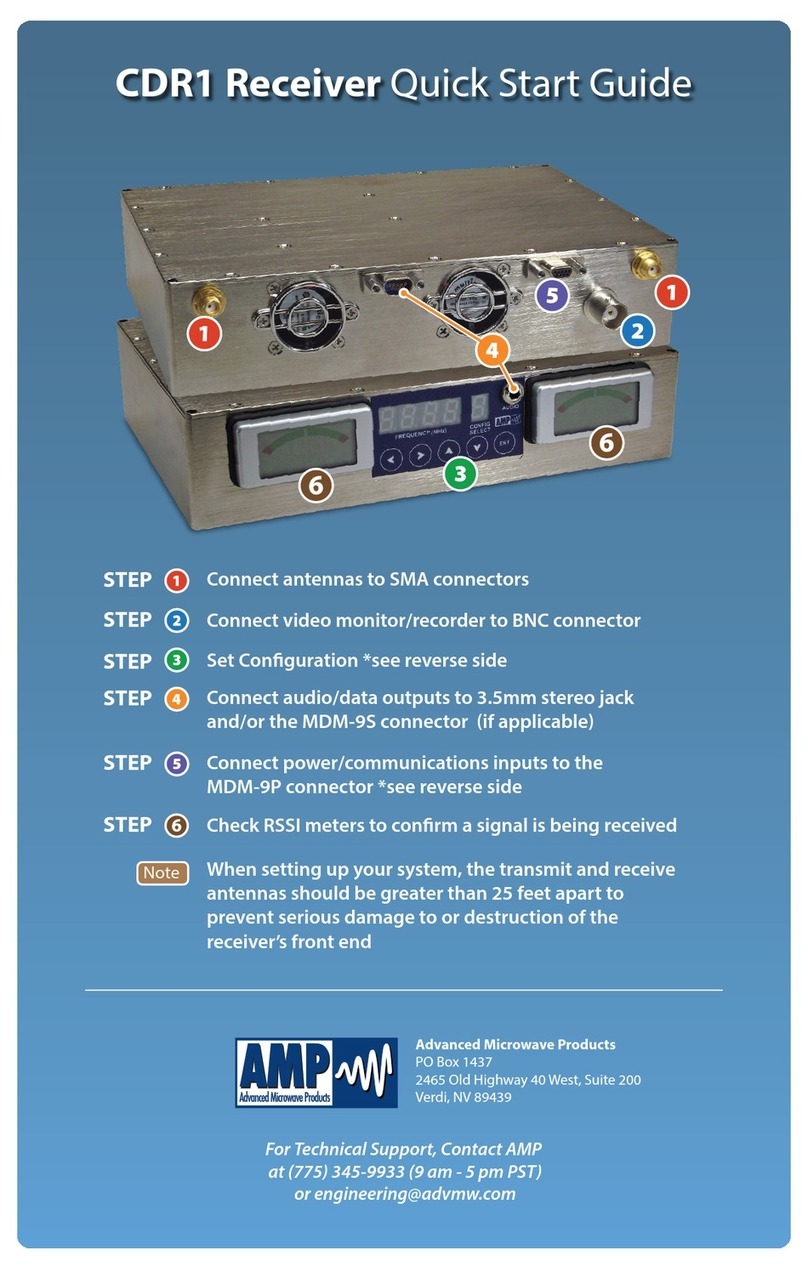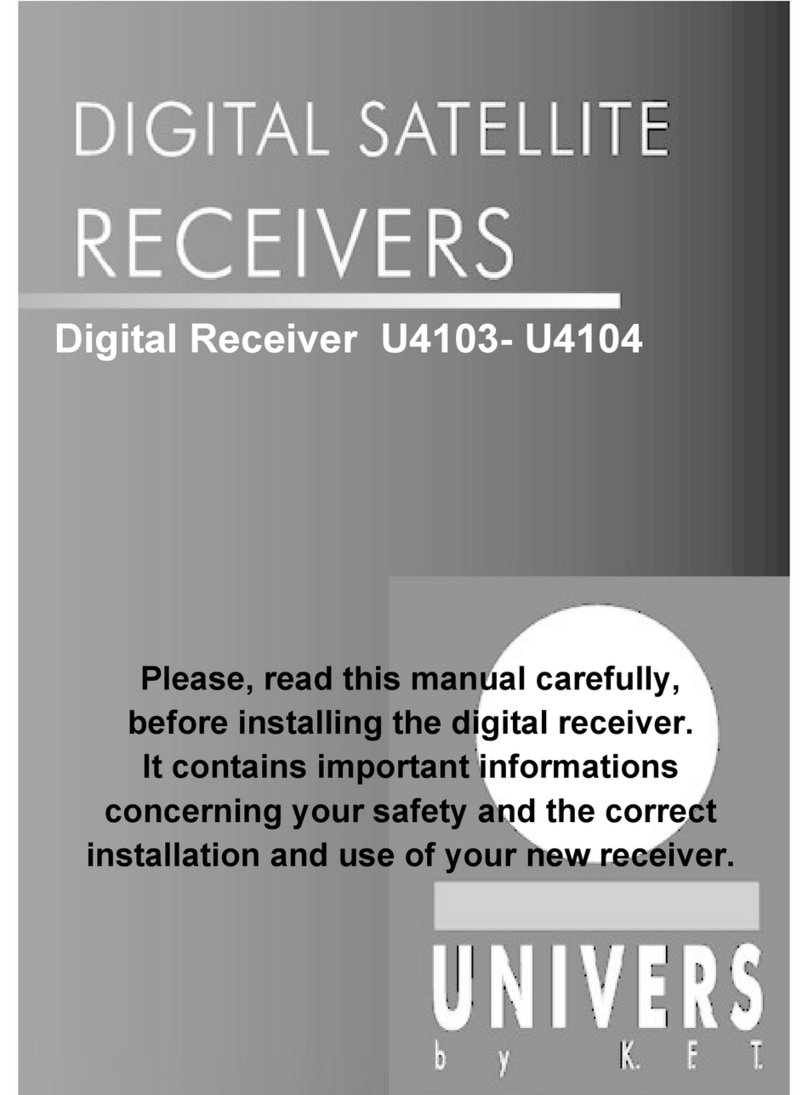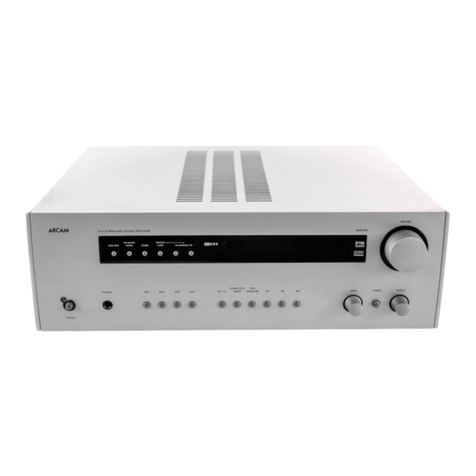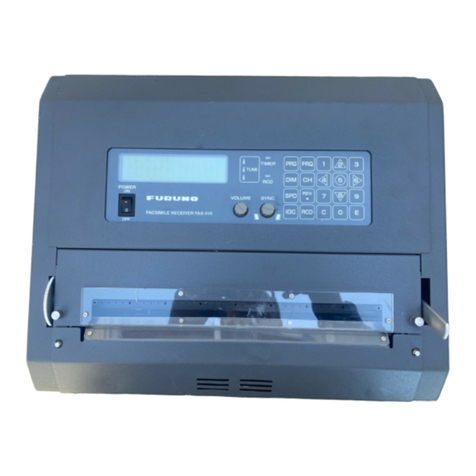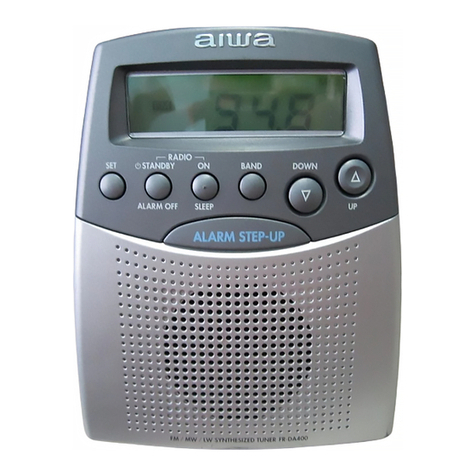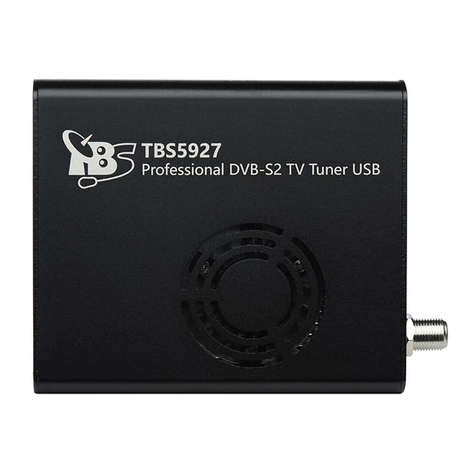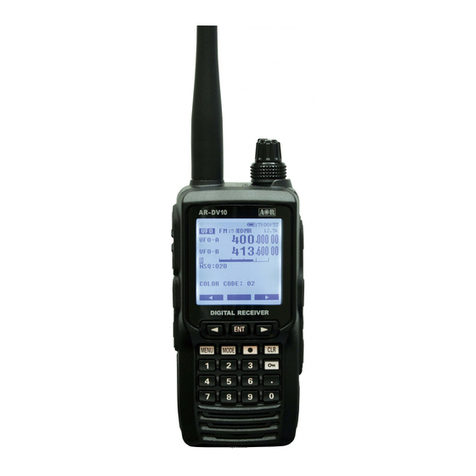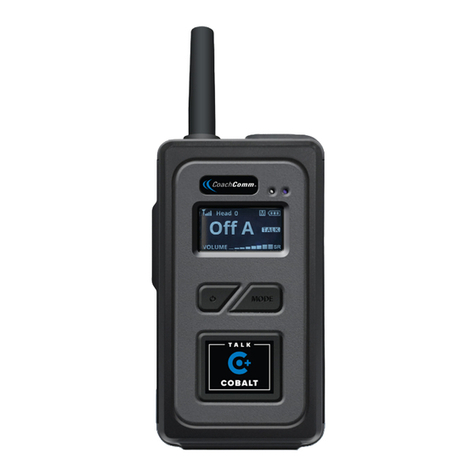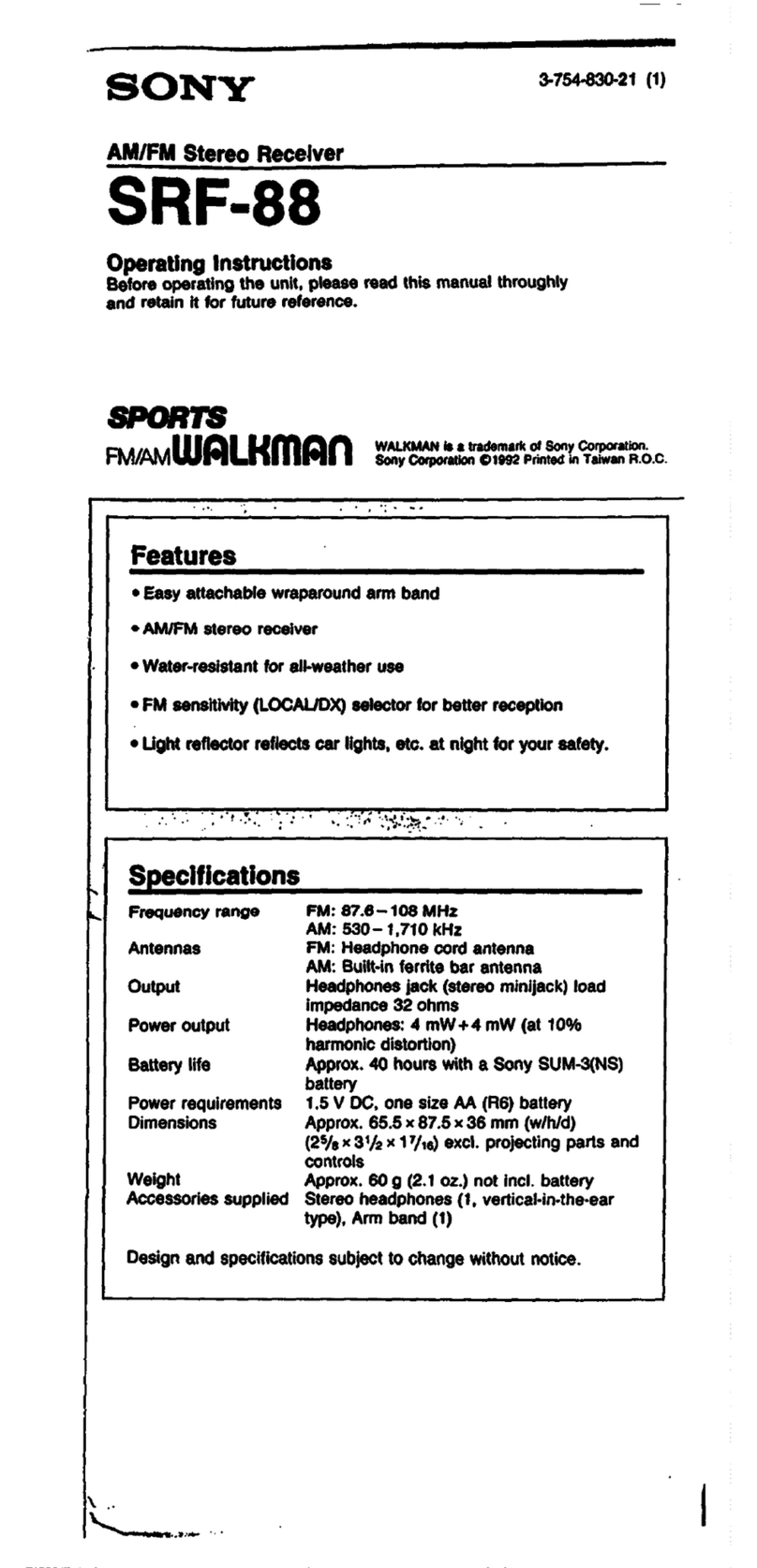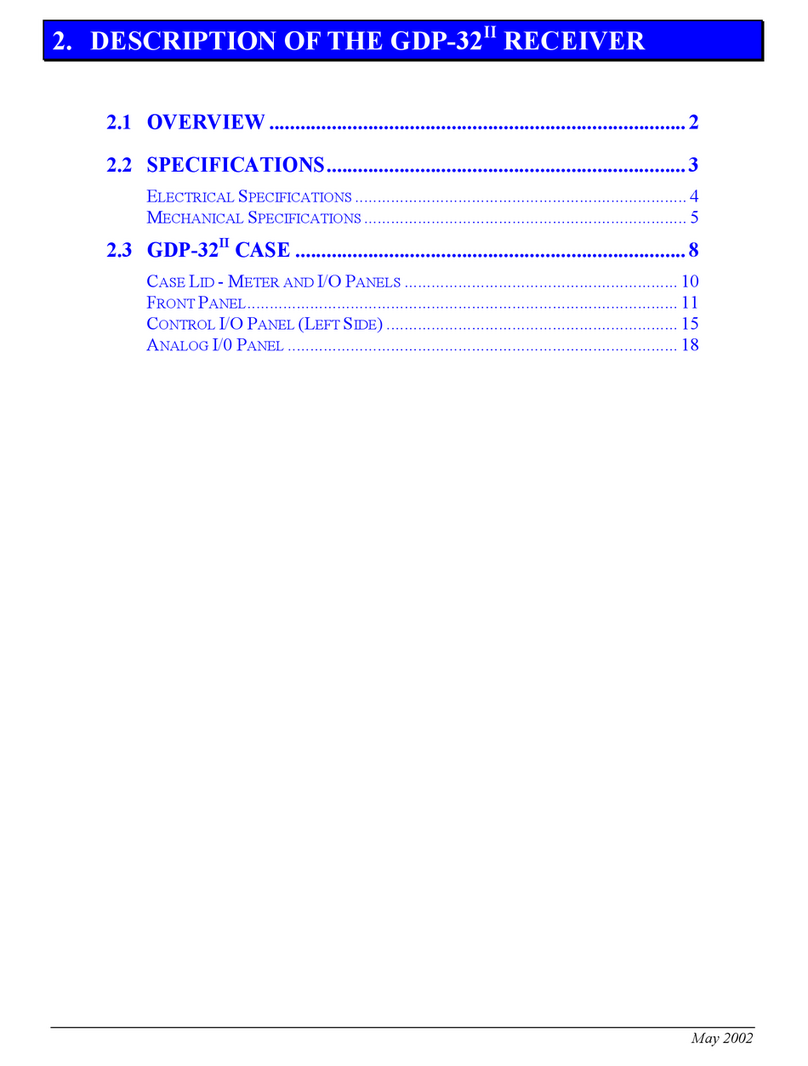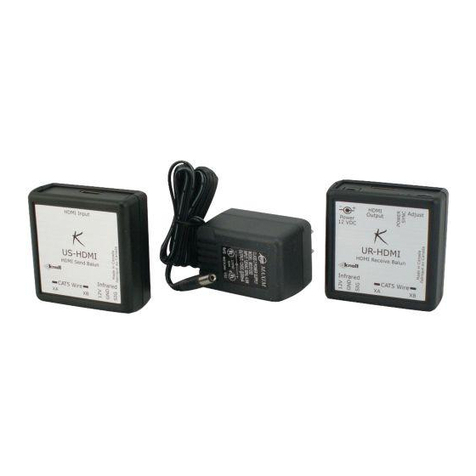FrSky HORUS X10 User manual

Introduction
Thank you for purchasing the FrSky Horus X10 digital telemetry radio system. In order to make the best use of your
system and to fly safely, please read this manual carefully. If you have any difficulties while using your system, please
consult the manual, your hobby dealer, or FrSky technical support.
Meanings of Special Markings
Pay special attention to safety where indicated by the following marks:
DANGER- Procedures which may lead to dangerous conditions and cause death/serious injury if not carried
out properly.
WARNING- Procedures which may lead to a dangerous condition or cause death or serious injury to the user
if not carried out properly or procedures where the probability of superficial injury or physical damage is high.
CAUTION- Procedures where the possibility of serious injury to the user is small, but there is a danger of injury,
or physical damage, if not carried out properly.
= Mandatory = Prohibited
Warning: Always keep electrical components away from small children.
FrSky Horus X10 Manual
Due to unforeseen changes in production, the information contained in this manual is subject to change without notice.
Cautions on handling antenna of External Module
Do not touch the antenna during operation. Doing so could interfere with transmission, causing a crash.
Do not carry the transmitter by the antenna. The antenna wire could break and prevent transmission.
Do not pull the antenna forcefully. The antenna wire could break and prevent transmission.
Specifications
Model Name: Horus X10
Number of Channels: 47 channels
Operating Voltage: DC 7.2V supplied by battery or DC 15V from adapter
Operating Temperature: -10~60℃
Industrial screen: high resolution TFT (480*272), readable outdoor
Compatibility: FrSky X series, D series, L series and V8-II series receivers (plus other receivers if an external module
is used)
16MB Flash
*SD card is not supplied with X10 Horus, please purchase separately.
● 6 position encoder for easier flight modes switch
● FrSky FrTX operation system
● Industrial High Resolution TFT Screen Readable
Outdoor
● Internal and External Antenna selectable
● Audio Speech Outputs (values, alarms, settings, etc.)
● Full telemetry and real-time data logging
● Antenna detection and SWR warning
● 6 ball bearings gimbals with accuracy hall
sensor and extensible by stick ends
● Inbuilt wireless trainer system
Features
Notice:
● When failsafe is disabled on X10 Horus side, the failsafe set on receiver side will be used.
● SBUS port always outputs, No Pulse could not perform properly on it. Set “Hold” or “Custom” for SBUS port.
●The above instructions do not apply to D-series and L-series receivers, which require the internal RF module of
Horus X10 to be in D8 mode or LR12 mode. For these receivers, failsafe must be set on the receiver side
(see receiver instructions).
Notes and Warnings for Battery & Charger
The 2S Li-Ion battery is for use only in your Horus X10.
Be sure to use the offered battery charger to charge the battery.
Be careful not to drop the battery.
Don't pull the battery wires as this could produce, short-circuits and cause the battery to explode.
Do not remove the battery from the Horus X10 transmitter while the voltage warning is blinking as this could
cause internal settings and memories to be destroyed.
Be sure to turn off the Horus X10 before charging the battery.
The Power Indicator LED in the charger will be on during charging, and be off after the charging is finished.
Model Setup for Horus X10 Internal RF Module
The internal RF module of FrSky Horus X10 is newly developed by FrSky under the name of IXJT.
Enter the RF SYSTEM menu (for details, download it from FrSky website).
Model Setup for Horus X10 External RF Module
● No Pulse: on loss of signal the receiver produces no pulses on any channel. To use this type, select it in the menu
and wait 9 seconds for the failsafe to take effect.
●Hold: the receiver continues to output the last positions before signal was lost. To use this type, select it in the menu
and wait 9 seconds for the failsafe to take effect.
●Custom: pre-set to required positions on lost signal. Move the cursor to the failsafe mode of channel and press Encoder,
then choose the Custom mode. Move the cursor to the channel you want to set failsafe on, and press Encoder.
Then rotate the Encoder to the place you want for failsafe and short press Encoder to finish the setting. Wait 9 seconds
before the failsafe takes effect.
Step 6: Range
Range refers to Horus X10 range check mode.
A pre-flight range check should be done before
each flying session. Move the cursor to “STATE”,
scroll the Encoder to select “RANGE” mode and
press Encoder.In range check mode, the effective
distance will be decreased to 1/30. Press “STATE”
turn to “NORMAL” then exit.
The external RF module can be powered on or off by
software. The setup process is the same as that for
the internal RF .
If you use other brand RF module than FrSky, please
choose PPM mode.
Step 2: Set the Channel Range
The internal RF module of Horus X10 supports 47 channels. The channel range is configurable, and needs
double check before use.
Step 3: Set the Receiver Number
When you create a new model, the system will assign you a receiver number automatically, but this can be
easily changed. The range of the receiver number is 01-47, with the default number being 01. Once the receiver
is set to the desired number and is bound to the Horus X10, the bind procedure will not need to be repeated
unless the receiver number is changed, In this case, either set the receiver number to the previous one,
repeat the bind procedure.
Step 4: Bind
Bind refers to Horus X10 binding mode. Move the cursor to “STATE”, press Encoder button, scroll the Encoder to
select “BIND” mode and then press Encoder button again, that the RF module has entered the bind mode. Then put
your receiver into binding mode and finish the bind procedure(refer to the receiver’s manual for details).Press
“STATE” turn to “NORMAL” then exit.
Step 5: Set Failsafe mode
There are 3 failsafe modes When enabled :
No Pulse, Hold, Custom.
Compatible Receivers Number of Output Channels
D8
D16
LR12
X series (X8R, etc.)
L series (L9R, etc.)
47 channels
47 channels
47 channels
V8-II series in D mode (V8FR-II,
V8R7-II, V8R4-II, VD5M, etc.)
D series (D8R-II plus, D8R-XP,
D6FR, D4R-II, etc.)
Note: older V8 receivers are not supported by the internal module but can be used with an external
DJT module in V8 mode.
Overview
(Switch Default Settings)
SA: 3 positions, Short Lever
SB: 3 positions, Long Lever
SC: 3 positions, Long Lever
SD: 3 positions, Short Lever
SE: 3 positions, Short Lever
SF: 2 positions, Long Lever
SG: 3 positions, Short lever
SH: 2 positions, Momentary;
Long Lever
You can choose the Switch and define
its positions in the Input and Output
Map screen.
Step 1: Set the Mode for Horus X10 Internal RF
Refer to the table below and set the HORUS X10
to the mode corresponding to your receiver (D8,
D16 or LR12 ).
Add:F-4,Building C, Zhongxiu Technology Park, No.3 Yuanxi Road, Wuxi, 214125, Jiangsu, China Technical Support: [email protected]
FrSky Electronic Co., Ltd www.frsky-rc.com Contact us : frsky@frsky-rc.com
Add:F-4,Building C, Zhongxiu Technology Park, No.3 Yuanxi Road, Wuxi, 214125, Jiangsu, China Technical Support: sales4tech@gmail.com
Add:F-4,Building C, Zhongxiu Technology Park, No.3 Yuanxi Road, Wuxi, 214125, Jiangsu, China Technical Support: [email protected]
FrSky Electronic Co., Ltd www.frsky-rc.com Contact us : frsky@frsky-rc.com
Add:F-4,Building C, Zhongxiu Technology Park, No.3 Yuanxi Road, Wuxi, 214125, Jiangsu, China Technical Support: sales4tech@gmail.com
Mode of Horus X10
USB Port
Smart Port Trainer port
Diaplay Screen
Speaker Power Swich
SA, SB, SE, SF
Stick
(J3)
(J4)
MDL,SYS,
RTN,TELE,
PgUp/PgDn,
LS
Charge Jack
SC, SD, SG, SH
S1, S2,
Stick
(J1)
(J2)
ENT
RS
Headset port

Introduction
Thank you for purchasing the FrSky Horus X10 digital telemetry radio system. In order to make the best use of your
system and to fly safely, please read this manual carefully. If you have any difficulties while using your system, please
consult the manual, your hobby dealer, or FrSky technical support.
Meanings of Special Markings
Pay special attention to safety where indicated by the following marks:
DANGER- Procedures which may lead to dangerous conditions and cause death/serious injury if not carried
out properly.
WARNING- Procedures which may lead to a dangerous condition or cause death or serious injury to the user
if not carried out properly or procedures where the probability of superficial injury or physical damage is high.
CAUTION- Procedures where the possibility of serious injury to the user is small, but there is a danger of injury,
or physical damage, if not carried out properly.
= Mandatory = Prohibited
Warning: Always keep electrical components away from small children.
FrSky Horus X10 Manual
Due to unforeseen changes in production, the information contained in this manual is subject to change without notice.
Cautions on handling antenna of External Module
Do not touch the antenna during operation. Doing so could interfere with transmission, causing a crash.
Do not carry the transmitter by the antenna. The antenna wire could break and prevent transmission.
Do not pull the antenna forcefully. The antenna wire could break and prevent transmission.
Specifications
Model Name: Horus X10
Number of Channels: 47 channels
Operating Voltage: DC 7.2V supplied by battery or DC 15V from adapter
Operating Temperature: -10~60℃
Industrial screen: high resolution TFT (480*272), readable outdoor
Compatibility: FrSky X series, D series, L series and V8-II series receivers (plus other receivers if an external module
is used)
16MB Flash
*SD card is not supplied with X10 Horus, please purchase separately.
● 6 position encoder for easier flight modes switch
● FrSky FrTX operation system
● Industrial High Resolution TFT Screen Readable
Outdoor
● Internal and External Antenna selectable
● Audio Speech Outputs (values, alarms, settings, etc.)
● Full telemetry and real-time data logging
● Antenna detection and SWR warning
● 6 ball bearings gimbals with accuracy hall
sensor and extensible by stick ends
● Inbuilt wireless trainer system
Features
Notice:
● When failsafe is disabled on X10 Horus side, the failsafe set on receiver side will be used.
● SBUS port always outputs, No Pulse could not perform properly on it. Set “Hold” or “Custom” for SBUS port.
●The above instructions do not apply to D-series and L-series receivers, which require the internal RF module of
Horus X10 to be in D8 mode or LR12 mode. For these receivers, failsafe must be set on the receiver side
(see receiver instructions).
Notes and Warnings for Battery & Charger
The 2S Li-Ion battery is for use only in your Horus X10.
Be sure to use the offered battery charger to charge the battery.
Be careful not to drop the battery.
Don't pull the battery wires as this could produce, short-circuits and cause the battery to explode.
Do not remove the battery from the Horus X10 transmitter while the voltage warning is blinking as this could
cause internal settings and memories to be destroyed.
Be sure to turn off the Horus X10 before charging the battery.
The Power Indicator LED in the charger will be on during charging, and be off after the charging is finished.
Model Setup for Horus X10 Internal RF Module
The internal RF module of FrSky Horus X10 is newly developed by FrSky under the name of IXJT.
Enter the RF SYSTEM menu (for details, download it from FrSky website).
Model Setup for Horus X10 External RF Module
● No Pulse: on loss of signal the receiver produces no pulses on any channel. To use this type, select it in the menu
and wait 9 seconds for the failsafe to take effect.
●Hold: the receiver continues to output the last positions before signal was lost. To use this type, select it in the menu
and wait 9 seconds for the failsafe to take effect.
●Custom: pre-set to required positions on lost signal. Move the cursor to the failsafe mode of channel and press Encoder,
then choose the Custom mode. Move the cursor to the channel you want to set failsafe on, and press Encoder.
Then rotate the Encoder to the place you want for failsafe and short press Encoder to finish the setting. Wait 9 seconds
before the failsafe takes effect.
Step 6: Range
Range refers to Horus X10 range check mode.
A pre-flight range check should be done before
each flying session. Move the cursor to “STATE”,
scroll the Encoder to select “RANGE” mode and
press Encoder.In range check mode, the effective
distance will be decreased to 1/30. Press “STATE”
turn to “NORMAL” then exit.
The external RF module can be powered on or off by
software. The setup process is the same as that for
the internal RF .
If you use other brand RF module than FrSky, please
choose PPM mode.
Step 2: Set the Channel Range
The internal RF module of Horus X10 supports 47 channels. The channel range is configurable, and needs
double check before use.
Step 3: Set the Receiver Number
When you create a new model, the system will assign you a receiver number automatically, but this can be
easily changed. The range of the receiver number is 01-47, with the default number being 01. Once the receiver
is set to the desired number and is bound to the Horus X10, the bind procedure will not need to be repeated
unless the receiver number is changed, In this case, either set the receiver number to the previous one,
repeat the bind procedure.
Step 4: Bind
Bind refers to Horus X10 binding mode. Move the cursor to “STATE”, press Encoder button, scroll the Encoder to
select “BIND” mode and then press Encoder button again, that the RF module has entered the bind mode. Then put
your receiver into binding mode and finish the bind procedure(refer to the receiver’s manual for details).Press
“STATE” turn to “NORMAL” then exit.
Step 5: Set Failsafe mode
There are 3 failsafe modes When enabled :
No Pulse, Hold, Custom.
Compatible Receivers Number of Output Channels
D8
D16
LR12
X series (X8R, etc.)
L series (L9R, etc.)
47 channels
47 channels
47 channels
V8-II series in D mode (V8FR-II,
V8R7-II, V8R4-II, VD5M, etc.)
D series (D8R-II plus, D8R-XP,
D6FR, D4R-II, etc.)
Note: older V8 receivers are not supported by the internal module but can be used with an external
DJT module in V8 mode.
Overview
(Switch Default Settings)
SA: 3 positions, Short Lever
SB: 3 positions, Long Lever
SC: 3 positions, Long Lever
SD: 3 positions, Short Lever
SE: 3 positions, Short Lever
SF: 2 positions, Long Lever
SG: 3 positions, Short lever
SH: 2 positions, Momentary;
Long Lever
You can choose the Switch and define
its positions in the Input and Output
Map screen.
Step 1: Set the Mode for Horus X10 Internal RF
Refer to the table below and set the HORUS X10
to the mode corresponding to your receiver (D8,
D16 or LR12 ).
Add:F-4,Building C, Zhongxiu Technology Park, No.3 Yuanxi Road, Wuxi, 214125, Jiangsu, China Technical Support: [email protected]
Add:F-4,Building C, Zhongxiu Technology Park, No.3 Yuanxi Road, Wuxi, 214125, Jiangsu, China Technical Support: [email protected]
Add:F-4,Building C, Zhongxiu Technology Park, No.3 Yuanxi Road, Wuxi, 214125, Jiangsu, China Technical Support: [email protected]
Add:F-4,Building C, Zhongxiu Technology Park, No.3 Yuanxi Road, Wuxi, 214125, Jiangsu, China Technical Support: [email protected]
Mode of Horus X10
USB Port
Smart Port Trainer port
Diaplay Screen
Speaker Power Swich
SA, SB, SE, SF
Stick
(J3)
(J4)
MDL,SYS,
RTN,TELE,
PgUp/PgDn,
LS
Charge Jack
SC, SD, SG, SH
S1, S2,
Stick
(J1)
(J2)
ENT
RS
Headset port

Introduction
Thank you for purchasing the FrSky Horus X10 digital telemetry radio system. In order to make the best use of your
system and to fly safely, please read this manual carefully. If you have any difficulties while using your system, please
consult the manual, your hobby dealer, or FrSky technical support.
Meanings of Special Markings
Pay special attention to safety where indicated by the following marks:
DANGER- Procedures which may lead to dangerous conditions and cause death/serious injury if not carried
out properly.
WARNING- Procedures which may lead to a dangerous condition or cause death or serious injury to the user
if not carried out properly or procedures where the probability of superficial injury or physical damage is high.
CAUTION- Procedures where the possibility of serious injury to the user is small, but there is a danger of injury,
or physical damage, if not carried out properly.
= Mandatory = Prohibited
Warning: Always keep electrical components away from small children.
FrSky Horus X10 Manual
Due to unforeseen changes in production, the information contained in this manual is subject to change without notice.
Cautions on handling antenna of External Module
Do not touch the antenna during operation. Doing so could interfere with transmission, causing a crash.
Do not carry the transmitter by the antenna. The antenna wire could break and prevent transmission.
Do not pull the antenna forcefully. The antenna wire could break and prevent transmission.
Specifications
Model Name: Horus X10
Number of Channels: 47 channels
Operating Voltage: DC 7.2V supplied by battery or DC 15V from adapter
Operating Temperature: -10~60℃
Industrial screen: high resolution TFT (480*272), readable outdoor
Compatibility: FrSky X series, D series, L series and V8-II series receivers (plus other receivers if an external module
is used)
16MB Flash
*SD card is not supplied with X10 Horus, please purchase separately.
● 6 position encoder for easier flight modes switch
● FrSky FrTX operation system
● Industrial High Resolution TFT Screen Readable
Outdoor
● Internal and External Antenna selectable
● Audio Speech Outputs (values, alarms, settings, etc.)
● Full telemetry and real-time data logging
● Antenna detection and SWR warning
● 6 ball bearings gimbals with accuracy hall
sensor and extensible by stick ends
● Inbuilt wireless trainer system
Features
Notice:
● When failsafe is disabled on X10 Horus side, the failsafe set on receiver side will be used.
● SBUS port always outputs, No Pulse could not perform properly on it. Set “Hold” or “Custom” for SBUS port.
●The above instructions do not apply to D-series and L-series receivers, which require the internal RF module of
Horus X10 to be in D8 mode or LR12 mode. For these receivers, failsafe must be set on the receiver side
(see receiver instructions).
Notes and Warnings for Battery & Charger
The 2S Li-Ion battery is for use only in your Horus X10.
Be sure to use the offered battery charger to charge the battery.
Be careful not to drop the battery.
Don't pull the battery wires as this could produce, short-circuits and cause the battery to explode.
Do not remove the battery from the Horus X10 transmitter while the voltage warning is blinking as this could
cause internal settings and memories to be destroyed.
Be sure to turn off the Horus X10 before charging the battery.
The Power Indicator LED in the charger will be on during charging, and be off after the charging is finished.
Model Setup for Horus X10 Internal RF Module
The internal RF module of FrSky Horus X10 is newly developed by FrSky under the name of IXJT.
Enter the RF SYSTEM menu (for details, download it from FrSky website).
Model Setup for Horus X10 External RF Module
● No Pulse: on loss of signal the receiver produces no pulses on any channel. To use this type, select it in the menu
and wait 9 seconds for the failsafe to take effect.
●Hold: the receiver continues to output the last positions before signal was lost. To use this type, select it in the menu
and wait 9 seconds for the failsafe to take effect.
●Custom: pre-set to required positions on lost signal. Move the cursor to the failsafe mode of channel and press Encoder,
then choose the Custom mode. Move the cursor to the channel you want to set failsafe on, and press Encoder.
Then rotate the Encoder to the place you want for failsafe and short press Encoder to finish the setting. Wait 9 seconds
before the failsafe takes effect.
Step 6: Range
Range refers to Horus X10 range check mode.
A pre-flight range check should be done before
each flying session. Move the cursor to “STATE”,
scroll the Encoder to select “RANGE” mode and
press Encoder.In range check mode, the effective
distance will be decreased to 1/30. Press “STATE”
turn to “NORMAL” then exit.
The external RF module can be powered on or off by
software. The setup process is the same as that for
the internal RF .
If you use other brand RF module than FrSky, please
choose PPM mode.
Step 2: Set the Channel Range
The internal RF module of Horus X10 supports 47 channels. The channel range is configurable, and needs
double check before use.
Step 3: Set the Receiver Number
When you create a new model, the system will assign you a receiver number automatically, but this can be
easily changed. The range of the receiver number is 01-47, with the default number being 01. Once the receiver
is set to the desired number and is bound to the Horus X10, the bind procedure will not need to be repeated
unless the receiver number is changed, In this case, either set the receiver number to the previous one,
repeat the bind procedure.
Step 4: Bind
Bind refers to Horus X10 binding mode. Move the cursor to “STATE”, press Encoder button, scroll the Encoder to
select “BIND” mode and then press Encoder button again, that the RF module has entered the bind mode. Then put
your receiver into binding mode and finish the bind procedure(refer to the receiver’s manual for details).Press
“STATE” turn to “NORMAL” then exit.
Step 5: Set Failsafe mode
There are 3 failsafe modes When enabled :
No Pulse, Hold, Custom.
Compatible Receivers Number of Output Channels
D8
D16
LR12
X series (X8R, etc.)
L series (L9R, etc.)
47 channels
47 channels
47 channels
V8-II series in D mode (V8FR-II,
V8R7-II, V8R4-II, VD5M, etc.)
D series (D8R-II plus, D8R-XP,
D6FR, D4R-II, etc.)
Note: older V8 receivers are not supported by the internal module but can be used with an external
DJT module in V8 mode.
Overview
(Switch Default Settings)
SA: 3 positions, Short Lever
SB: 3 positions, Long Lever
SC: 3 positions, Long Lever
SD: 3 positions, Short Lever
SE: 3 positions, Short Lever
SF: 2 positions, Long Lever
SG: 3 positions, Short lever
SH: 2 positions, Momentary;
Long Lever
You can choose the Switch and define
its positions in the Input and Output
Map screen.
Step 1: Set the Mode for Horus X10 Internal RF
Refer to the table below and set the HORUS X10
to the mode corresponding to your receiver (D8,
D16 or LR12 ).
FrSky Electronic Co., Ltd www.frsky-rc.com Contact us : frsky@frsky-rc.com
Add:F-4,Building C, Zhongxiu Technology Park, No.3 Yuanxi Road, Wuxi, 214125, Jiangsu, China Technical Support: sales4tech@gmail.com
FrSky Electronic Co., Ltd www.frsky-rc.com Contact us : frsky@frsky-rc.com
Add:F-4,Building C, Zhongxiu Technology Park, No.3 Yuanxi Road, Wuxi, 214125, Jiangsu, China Technical Support: sales4tech@gmail.com
Add:F-4,Building C, Zhongxiu Technology Park, No.3 Yuanxi Road, Wuxi, 214125, Jiangsu, China Technical Support: [email protected]
FrSky Electronic Co., Ltd www.frsky-rc.com Contact us : frsky@frsky-rc.com
Add:F-4,Building C, Zhongxiu Technology Park, No.3 Yuanxi Road, Wuxi, 214125, Jiangsu, China Technical Support: sales4tech@gmail.com
Mode of Horus X10
USB Port
Smart Port Trainer port
Diaplay Screen
Speaker Power Swich
SA, SB, SE, SF
Stick
(J3)
(J4)
MDL,SYS,
RTN,TELE,
PgUp/PgDn,
LS
Charge Jack
SC, SD, SG, SH
S1, S2,
Stick
(J1)
(J2)
ENT
RS
Headset port

Introduction
Thank you for purchasing the FrSky Horus X10 digital telemetry radio system. In order to make the best use of your
system and to fly safely, please read this manual carefully. If you have any difficulties while using your system, please
consult the manual, your hobby dealer, or FrSky technical support.
Meanings of Special Markings
Pay special attention to safety where indicated by the following marks:
DANGER- Procedures which may lead to dangerous conditions and cause death/serious injury if not carried
out properly.
WARNING- Procedures which may lead to a dangerous condition or cause death or serious injury to the user
if not carried out properly or procedures where the probability of superficial injury or physical damage is high.
CAUTION- Procedures where the possibility of serious injury to the user is small, but there is a danger of injury,
or physical damage, if not carried out properly.
= Mandatory = Prohibited
Warning: Always keep electrical components away from small children.
FrSky Horus X10 Manual
Due to unforeseen changes in production, the information contained in this manual is subject to change without notice.
Cautions on handling antenna of External Module
Do not touch the antenna during operation. Doing so could interfere with transmission, causing a crash.
Do not carry the transmitter by the antenna. The antenna wire could break and prevent transmission.
Do not pull the antenna forcefully. The antenna wire could break and prevent transmission.
Specifications
Model Name: Horus X10
Number of Channels: 47 channels
Operating Voltage: DC 7.2V supplied by battery or DC 15V from adapter
Operating Temperature: -10~60℃
Industrial screen: high resolution TFT (480*272), readable outdoor
Compatibility: FrSky X series, D series, L series and V8-II series receivers (plus other receivers if an external module
is used)
16MB Flash
*SD card is not supplied with X10 Horus, please purchase separately.
● 6 position encoder for easier flight modes switch
● FrSky FrTX operation system
● Industrial High Resolution TFT Screen Readable
Outdoor
● Internal and External Antenna selectable
● Audio Speech Outputs (values, alarms, settings, etc.)
● Full telemetry and real-time data logging
● Antenna detection and SWR warning
● 6 ball bearings gimbals with accuracy hall
sensor and extensible by stick ends
● Inbuilt wireless trainer system
Features
Notice:
● When failsafe is disabled on X10 Horus side, the failsafe set on receiver side will be used.
● SBUS port always outputs, No Pulse could not perform properly on it. Set “Hold” or “Custom” for SBUS port.
●The above instructions do not apply to D-series and L-series receivers, which require the internal RF module of
Horus X10 to be in D8 mode or LR12 mode. For these receivers, failsafe must be set on the receiver side
(see receiver instructions).
Notes and Warnings for Battery & Charger
The 2S Li-Ion battery is for use only in your Horus X10.
Be sure to use the offered battery charger to charge the battery.
Be careful not to drop the battery.
Don't pull the battery wires as this could produce, short-circuits and cause the battery to explode.
Do not remove the battery from the Horus X10 transmitter while the voltage warning is blinking as this could
cause internal settings and memories to be destroyed.
Be sure to turn off the Horus X10 before charging the battery.
The Power Indicator LED in the charger will be on during charging, and be off after the charging is finished.
Model Setup for Horus X10 Internal RF Module
The internal RF module of FrSky Horus X10 is newly developed by FrSky under the name of IXJT.
Enter the RF SYSTEM menu (for details, download it from FrSky website).
Model Setup for Horus X10 External RF Module
● No Pulse: on loss of signal the receiver produces no pulses on any channel. To use this type, select it in the menu
and wait 9 seconds for the failsafe to take effect.
●Hold: the receiver continues to output the last positions before signal was lost. To use this type, select it in the menu
and wait 9 seconds for the failsafe to take effect.
●Custom: pre-set to required positions on lost signal. Move the cursor to the failsafe mode of channel and press Encoder,
then choose the Custom mode. Move the cursor to the channel you want to set failsafe on, and press Encoder.
Then rotate the Encoder to the place you want for failsafe and short press Encoder to finish the setting. Wait 9 seconds
before the failsafe takes effect.
Step 6: Range
Range refers to Horus X10 range check mode.
A pre-flight range check should be done before
each flying session. Move the cursor to “STATE”,
scroll the Encoder to select “RANGE” mode and
press Encoder.In range check mode, the effective
distance will be decreased to 1/30. Press “STATE”
turn to “NORMAL” then exit.
The external RF module can be powered on or off by
software. The setup process is the same as that for
the internal RF .
If you use other brand RF module than FrSky, please
choose PPM mode.
Step 2: Set the Channel Range
The internal RF module of Horus X10 supports 47 channels. The channel range is configurable, and needs
double check before use.
Step 3: Set the Receiver Number
When you create a new model, the system will assign you a receiver number automatically, but this can be
easily changed. The range of the receiver number is 01-47, with the default number being 01. Once the receiver
is set to the desired number and is bound to the Horus X10, the bind procedure will not need to be repeated
unless the receiver number is changed, In this case, either set the receiver number to the previous one,
repeat the bind procedure.
Step 4: Bind
Bind refers to Horus X10 binding mode. Move the cursor to “STATE”, press Encoder button, scroll the Encoder to
select “BIND” mode and then press Encoder button again, that the RF module has entered the bind mode. Then put
your receiver into binding mode and finish the bind procedure(refer to the receiver’s manual for details).Press
“STATE” turn to “NORMAL” then exit.
Step 5: Set Failsafe mode
There are 3 failsafe modes When enabled :
No Pulse, Hold, Custom.
Compatible Receivers Number of Output Channels
D8
D16
LR12
X series (X8R, etc.)
L series (L9R, etc.)
47 channels
47 channels
47 channels
V8-II series in D mode (V8FR-II,
V8R7-II, V8R4-II, VD5M, etc.)
D series (D8R-II plus, D8R-XP,
D6FR, D4R-II, etc.)
Note: older V8 receivers are not supported by the internal module but can be used with an external
DJT module in V8 mode.
Overview
(Switch Default Settings)
SA: 3 positions, Short Lever
SB: 3 positions, Long Lever
SC: 3 positions, Long Lever
SD: 3 positions, Short Lever
SE: 3 positions, Short Lever
SF: 2 positions, Long Lever
SG: 3 positions, Short lever
SH: 2 positions, Momentary;
Long Lever
You can choose the Switch and define
its positions in the Input and Output
Map screen.
Step 1: Set the Mode for Horus X10 Internal RF
Refer to the table below and set the HORUS X10
to the mode corresponding to your receiver (D8,
D16 or LR12 ).
FrSky Electronic Co., Ltd www.frsky-rc.com Contact us : frsky@frsky-rc.com
Add:F-4,Building C, Zhongxiu Technology Park, No.3 Yuanxi Road, Wuxi, 214125, Jiangsu, China Technical Support: sales4tech@gmail.com
FrSky Electronic Co., Ltd www.frsky-rc.com Contact us : frsky@frsky-rc.com
Add:F-4,Building C, Zhongxiu Technology Park, No.3 Yuanxi Road, Wuxi, 214125, Jiangsu, China Technical Support: sales4tech@gmail.com
Add:F-4,Building C, Zhongxiu Technology Park, No.3 Yuanxi Road, Wuxi, 214125, Jiangsu, China Technical Support: [email protected]
Add:F-4,Building C, Zhongxiu Technology Park, No.3 Yuanxi Road, Wuxi, 214125, Jiangsu, China Technical Support: [email protected]
Mode of Horus X10
USB Port
Smart Port Trainer port
Diaplay Screen
Speaker Power Swich
SA, SB, SE, SF
Stick
(J3)
(J4)
MDL,SYS,
RTN,TELE,
PgUp/PgDn,
LS
Charge Jack
SC, SD, SG, SH
S1, S2,
Stick
(J1)
(J2)
ENT
RS
Headset port

FCC Statement
The product may be used freely in these countries: Germany, UK, France,Italy, Spain, Belgium, Netherlands,
Portugal, Greece, Ireland, Denmark, Luxembourg, Austria, Finland, Sweden, Norway and Iceland.
CE
FLYING SAFETY
Li-Ion Battery Safety and Handling instructions
IMPORTANT! The
Li-Ion
battery (NiMH) batteries included in the Horus X10 transmitter are not to be confused with
Li-Ion
batteries, or any other type of rechargeable battery (including NiCd and LiFe).
Li-Ion
batteries require special
charging criteria different than other rechargeable batteries. Use only the FrSky transmitter charger included with
this set for, or other chargers approved by FrSky, to charge the
Li-Ion
batteries in the HORUS X10 transmitter.
It’s important to understand the operating characteristics of Nickel–Metal Hydride battery (NiMH). Read the
specificationsprinted on the label of your NiMH battery and charger prior to use. Failure to follow the these
precautions can quickly result in severe, permanent damage to the battery and its surroundings and possibly result
in a FIRE!
FrSky is continuously adding features and improvements to our radio systems. Updating (via the pre-installed MicroSD
card in Horus X10 TF Card Slot) is easy and free. To get the most from your new transmitter, please check the download
section of the FrSky website www.frsky-rc.com, for the latest update firmware and how-to guide.
Horus X10 installed the FrSky FrTX operation system. Do not hesitate to contact FrSky if you have ideas and suggestions
for current and future radio systems, or if you are willing to join the FrSky developing union to be part of the projects.
﹡The currently pre-installed firmware of Horus X10 is FrSky FrTX firmware, developed and well tested by FrSky.
The transmitter also support the open source firmware.
Updates
Changes or modifications not expressly approved by the party responsible for compliance could void the
user's authority to operate the equipment.
This device complies with part 15 of the FCC Rules. Operation is subject to the following two conditions: (1)
This device may not cause harmful interference, and (2) this device must accept any interference received,
including interference that may cause undesired operation.
RF warning statement:
This equipment complies with FCC radiation exposure limits set forth for an uncontrolled environment .The
device has been evaluated to meet general RF exposure requirement. The device can be used in portable
exposure condition without restriction.
Where to Fly
We recommend that you fly at a recognized model airplane flying field. You can find model clubs and fields by
asking your nearest hobby dealer.
Always pay particular attention to the flying field’s rules, as well as the presence and location of spectators,
the wind direction, and any obstacles on the field. Be very careful flying in areas near power lines, tall buildings,
or communication facilities as there may be radio interference in their vicinity.
At the flying field
To prevent possible damage to your radio gear, turn the power switches on and off in the proper sequence:
1. Pull throttle stick to idle position, or otherwise disarm your motor/engine.
2. Turn on the transmitter power and allow your transmitter to reach its home screen.
3. Confirm the proper model memory has been selected.
4. Turn on your receiver power.
5. Test all controls. If a servo operates abnormally, don’t attempt to fly until you determine the cause of
the problem. (For PCM systems only: Test to ensure that the Failsafe settings are correct by waiting
at least 2 minutes after adjusting then, turning the transmitter off and confirming the proper surface/
throttle movements. Turn the transmitter back on.)
6. Start your engine.
7. Complete a full range check.
8. After flying, bring the throttle stick to idle position, engage any kill switches or otherwise disarm your
motor/engine.
If you do not turn on your system on and off in this order, you may damage your servos or control surfaces,
flood your engine, or in the case of electric-powered or gasoline-powered models, the engine may unexpectedly
turn on and cause a severe injury.
Make sure your transmitter can’t tip it over. If it is knocked over, the throttle stick may be accidentally
moved, causing the engine to speed up. Also, damage to your transmitter may occur.
In order to maintain complete control of your aircraft it is important that it remains visible at all times. Flying
behind large objects such as buildings, grain bins, etc. must be avoided. Doing so may interrupt the radio
frequency link to the model, resulting in loss of control.
Do not grasp the transmitter's antenna during flight. Doing so may degrade the quality of the radio frequency
transmission and could result in loss of control.
As with all radio frequency transmissions, the strongest area of signal transmission is from the sides of the
transmitter's antenna. As such, the antenna should not be pointed directly at the model. If your flying style
creates this situation, easily move the antenna to correct this situation
Before taxiing, be sure to extend the transmitter antenna to its full length.
A collapsed antenna will reduce your flying range and cause a loss of control. It is a good idea to avoid pointing
the transmitter antenna directly at the model, since the signal is weakest in that direction.
Don’t fly in the rain! Water or moisture may enter the transmitter through the antenna or stick openings
and cause erratic operation or loss of control. If you must fly in wet weather during a contest, be sure to cover
your transmitter with a plastic bag or waterproof barrier. Never fly if lightning is expected.
Warning:
To ensure the safety of yourself and others, please observe the following precautions.
Have regular maintenance performed. Although your Horus X10 protects the model memories with
non-volatile EEPROM memory (which does not require periodic replacement) and of a battery, it still should have
regular check-ups for wear and tear. We recommend sending your system to your FrSky Service Center annually
during your non-flying-season for a complete check-up and service.
Battery
Charge the batteries! Using the standard Horus battery and charger, always recharge the transmitter and
receiver batteries for at least 8 hours before each flying session. A low battery will soon die, causing loss of control
and a crash. When you begin your flying session, reset your transmitter’s built-in timer, and during the session
pay attention to the duration of usage. Also, if your model uses a separate receiver battery, make sure it is fully
charged before each flying session.
Stop flying long before your batteries become low on charge. Do not rely on your radio’s low battery
warning systems, intended only as a precaution, to tell you when to recharge. Always check your transmitter
and receiver batteries prior to each flight.
Do not leave a
Li-Ion
battery unattended at any time while being charged or discharged.
Do not attempt to charge
Li-Ion
batteries with a charger that is NOT designed for NiMH batteries, as permanent
damage to the battery and charger could result.
Always charge
Li-Ion
batteries in a fireproof location. Do not charge or discharge
Li-Ion
batteries on carpet, a
cluttered workbench, near paper, plastic, vinyl, leather or wood, or inside an R/C model or full-sized automobile!
Monitor the charge area with a smoke or fire alarm.
Do not charge NiMH batteries at currents greater than the “1C” rating of the battery (“C” equals the rated capacity
of the battery).
Do not allow
Li-Ion
cells to overheat at any time! Cells which reach greater than 140 degrees Fahrenheit (60°C)
should be placed in a fireproof location.
Li-Ion
cells will not charge fully when too cold or show full charge.
It is normal for the batteries to become warm during charging, but if the charger or battery becomes excessively
hot disconnect the battery from the charger immediately!! Always inspect for potential damage any battery
which has previously overheated for potential damage, and do not re-use if you suspect it has been damaged
in any way.
Do not use a
Li-Ion
battery if you suspect physical damage has occurred to the pack. Carefully inspect the
battery for even the smallest of dents, cracks, splits, punctures or damage to the wiring and connectors. DO
NOT allow the battery’s internal electrolyte to get into eyes or on skin—wash affected areas immediately if they
come in.
IMPORTANT PRECAUTIONS
Add:F-4,Building C, Zhongxiu Technology Park, No.3 Yuanxi Road, Wuxi, 214125, Jiangsu, China Technical Support: [email protected]
FrSky Electronic Co., Ltd www.frsky-rc.com Contact us : frsky@frsky-rc.com
Add:F-4,Building C, Zhongxiu Technology Park, No.3 Yuanxi Road, Wuxi, 214125, Jiangsu, China Technical Support: sales4tech@gmail.com
Add:F-4,Building C, Zhongxiu Technology Park, No.3 Yuanxi Road, Wuxi, 214125, Jiangsu, China Technical Support: [email protected]

FCC Statement
The product may be used freely in these countries: Germany, UK, France,Italy, Spain, Belgium, Netherlands,
Portugal, Greece, Ireland, Denmark, Luxembourg, Austria, Finland, Sweden, Norway and Iceland.
CE
FLYING SAFETY
Li-Ion Battery Safety and Handling instructions
IMPORTANT! The
Li-Ion
battery (NiMH) batteries included in the Horus X10 transmitter are not to be confused with
Li-Ion
batteries, or any other type of rechargeable battery (including NiCd and LiFe).
Li-Ion
batteries require special
charging criteria different than other rechargeable batteries. Use only the FrSky transmitter charger included with
this set for, or other chargers approved by FrSky, to charge the
Li-Ion
batteries in the HORUS X10 transmitter.
It’s important to understand the operating characteristics of Nickel–Metal Hydride battery (NiMH). Read the
specificationsprinted on the label of your NiMH battery and charger prior to use. Failure to follow the these
precautions can quickly result in severe, permanent damage to the battery and its surroundings and possibly result
in a FIRE!
FrSky is continuously adding features and improvements to our radio systems. Updating (via the pre-installed MicroSD
card in Horus X10 TF Card Slot) is easy and free. To get the most from your new transmitter, please check the download
section of the FrSky website www.frsky-rc.com, for the latest update firmware and how-to guide.
Horus X10 installed the FrSky FrTX operation system. Do not hesitate to contact FrSky if you have ideas and suggestions
for current and future radio systems, or if you are willing to join the FrSky developing union to be part of the projects.
﹡The currently pre-installed firmware of Horus X10 is FrSky FrTX firmware, developed and well tested by FrSky.
The transmitter also support the open source firmware.
Updates
Changes or modifications not expressly approved by the party responsible for compliance could void the
user's authority to operate the equipment.
This device complies with part 15 of the FCC Rules. Operation is subject to the following two conditions: (1)
This device may not cause harmful interference, and (2) this device must accept any interference received,
including interference that may cause undesired operation.
RF warning statement:
This equipment complies with FCC radiation exposure limits set forth for an uncontrolled environment .The
device has been evaluated to meet general RF exposure requirement. The device can be used in portable
exposure condition without restriction.
Where to Fly
We recommend that you fly at a recognized model airplane flying field. You can find model clubs and fields by
asking your nearest hobby dealer.
Always pay particular attention to the flying field’s rules, as well as the presence and location of spectators,
the wind direction, and any obstacles on the field. Be very careful flying in areas near power lines, tall buildings,
or communication facilities as there may be radio interference in their vicinity.
At the flying field
To prevent possible damage to your radio gear, turn the power switches on and off in the proper sequence:
1. Pull throttle stick to idle position, or otherwise disarm your motor/engine.
2. Turn on the transmitter power and allow your transmitter to reach its home screen.
3. Confirm the proper model memory has been selected.
4. Turn on your receiver power.
5. Test all controls. If a servo operates abnormally, don’t attempt to fly until you determine the cause of
the problem. (For PCM systems only: Test to ensure that the Failsafe settings are correct by waiting
at least 2 minutes after adjusting then, turning the transmitter off and confirming the proper surface/
throttle movements. Turn the transmitter back on.)
6. Start your engine.
7. Complete a full range check.
8. After flying, bring the throttle stick to idle position, engage any kill switches or otherwise disarm your
motor/engine.
If you do not turn on your system on and off in this order, you may damage your servos or control surfaces,
flood your engine, or in the case of electric-powered or gasoline-powered models, the engine may unexpectedly
turn on and cause a severe injury.
Make sure your transmitter can’t tip it over. If it is knocked over, the throttle stick may be accidentally
moved, causing the engine to speed up. Also, damage to your transmitter may occur.
In order to maintain complete control of your aircraft it is important that it remains visible at all times. Flying
behind large objects such as buildings, grain bins, etc. must be avoided. Doing so may interrupt the radio
frequency link to the model, resulting in loss of control.
Do not grasp the transmitter's antenna during flight. Doing so may degrade the quality of the radio frequency
transmission and could result in loss of control.
As with all radio frequency transmissions, the strongest area of signal transmission is from the sides of the
transmitter's antenna. As such, the antenna should not be pointed directly at the model. If your flying style
creates this situation, easily move the antenna to correct this situation
Before taxiing, be sure to extend the transmitter antenna to its full length.
A collapsed antenna will reduce your flying range and cause a loss of control. It is a good idea to avoid pointing
the transmitter antenna directly at the model, since the signal is weakest in that direction.
Don’t fly in the rain! Water or moisture may enter the transmitter through the antenna or stick openings
and cause erratic operation or loss of control. If you must fly in wet weather during a contest, be sure to cover
your transmitter with a plastic bag or waterproof barrier. Never fly if lightning is expected.
Warning:
To ensure the safety of yourself and others, please observe the following precautions.
Have regular maintenance performed. Although your Horus X10 protects the model memories with
non-volatile EEPROM memory (which does not require periodic replacement) and of a battery, it still should have
regular check-ups for wear and tear. We recommend sending your system to your FrSky Service Center annually
during your non-flying-season for a complete check-up and service.
Battery
Charge the batteries! Using the standard Horus battery and charger, always recharge the transmitter and
receiver batteries for at least 8 hours before each flying session. A low battery will soon die, causing loss of control
and a crash. When you begin your flying session, reset your transmitter’s built-in timer, and during the session
pay attention to the duration of usage. Also, if your model uses a separate receiver battery, make sure it is fully
charged before each flying session.
Stop flying long before your batteries become low on charge. Do not rely on your radio’s low battery
warning systems, intended only as a precaution, to tell you when to recharge. Always check your transmitter
and receiver batteries prior to each flight.
Do not leave a
Li-Ion
battery unattended at any time while being charged or discharged.
Do not attempt to charge
Li-Ion
batteries with a charger that is NOT designed for NiMH batteries, as permanent
damage to the battery and charger could result.
Always charge
Li-Ion
batteries in a fireproof location. Do not charge or discharge
Li-Ion
batteries on carpet, a
cluttered workbench, near paper, plastic, vinyl, leather or wood, or inside an R/C model or full-sized automobile!
Monitor the charge area with a smoke or fire alarm.
Do not charge NiMH batteries at currents greater than the “1C” rating of the battery (“C” equals the rated capacity
of the battery).
Do not allow
Li-Ion
cells to overheat at any time! Cells which reach greater than 140 degrees Fahrenheit (60°C)
should be placed in a fireproof location.
Li-Ion
cells will not charge fully when too cold or show full charge.
It is normal for the batteries to become warm during charging, but if the charger or battery becomes excessively
hot disconnect the battery from the charger immediately!! Always inspect for potential damage any battery
which has previously overheated for potential damage, and do not re-use if you suspect it has been damaged
in any way.
Do not use a
Li-Ion
battery if you suspect physical damage has occurred to the pack. Carefully inspect the
battery for even the smallest of dents, cracks, splits, punctures or damage to the wiring and connectors. DO
NOT allow the battery’s internal electrolyte to get into eyes or on skin—wash affected areas immediately if they
come in.
IMPORTANT PRECAUTIONS
FrSky Electronic Co., Ltd www.frsky-rc.com Contact us : frsky@frsky-rc.com
Add:F-4,Building C, Zhongxiu Technology Park, No.3 Yuanxi Road, Wuxi, 214125, Jiangsu, China Technical Support: sales4tech@gmail.com
FrSky Electronic Co., Ltd www.frsky-rc.com Contact us : frsky@frsky-rc.com
Add:F-4,Building C, Zhongxiu Technology Park, No.3 Yuanxi Road, Wuxi, 214125, Jiangsu, China Technical Support: sales4tech@gmail.com
FrSky Electronic Co., Ltd www.frsky-rc.com Contact us : frsky@frsky-rc.com
Add:F-4,Building C, Zhongxiu Technology Park, No.3 Yuanxi Road, Wuxi, 214125, Jiangsu, China Technical Support: sales4tech@gmail.com

FCC Statement
The product may be used freely in these countries: Germany, UK, France,Italy, Spain, Belgium, Netherlands,
Portugal, Greece, Ireland, Denmark, Luxembourg, Austria, Finland, Sweden, Norway and Iceland.
CE
FLYING SAFETY
Li-Ion Battery Safety and Handling instructions
IMPORTANT! The
Li-Ion
battery (NiMH) batteries included in the Horus X10 transmitter are not to be confused with
Li-Ion
batteries, or any other type of rechargeable battery (including NiCd and LiFe).
Li-Ion
batteries require special
charging criteria different than other rechargeable batteries. Use only the FrSky transmitter charger included with
this set for, or other chargers approved by FrSky, to charge the
Li-Ion
batteries in the HORUS X10 transmitter.
It’s important to understand the operating characteristics of Nickel–Metal Hydride battery (NiMH). Read the
specificationsprinted on the label of your NiMH battery and charger prior to use. Failure to follow the these
precautions can quickly result in severe, permanent damage to the battery and its surroundings and possibly result
in a FIRE!
FrSky is continuously adding features and improvements to our radio systems. Updating (via the pre-installed MicroSD
card in Horus X10 TF Card Slot) is easy and free. To get the most from your new transmitter, please check the download
section of the FrSky website www.frsky-rc.com, for the latest update firmware and how-to guide.
Horus X10 installed the FrSky FrTX operation system. Do not hesitate to contact FrSky if you have ideas and suggestions
for current and future radio systems, or if you are willing to join the FrSky developing union to be part of the projects.
﹡The currently pre-installed firmware of Horus X10 is FrSky FrTX firmware, developed and well tested by FrSky.
The transmitter also support the open source firmware.
Updates
Changes or modifications not expressly approved by the party responsible for compliance could void the
user's authority to operate the equipment.
This device complies with part 15 of the FCC Rules. Operation is subject to the following two conditions: (1)
This device may not cause harmful interference, and (2) this device must accept any interference received,
including interference that may cause undesired operation.
RF warning statement:
This equipment complies with FCC radiation exposure limits set forth for an uncontrolled environment .The
device has been evaluated to meet general RF exposure requirement. The device can be used in portable
exposure condition without restriction.
Where to Fly
We recommend that you fly at a recognized model airplane flying field. You can find model clubs and fields by
asking your nearest hobby dealer.
Always pay particular attention to the flying field’s rules, as well as the presence and location of spectators,
the wind direction, and any obstacles on the field. Be very careful flying in areas near power lines, tall buildings,
or communication facilities as there may be radio interference in their vicinity.
At the flying field
To prevent possible damage to your radio gear, turn the power switches on and off in the proper sequence:
1. Pull throttle stick to idle position, or otherwise disarm your motor/engine.
2. Turn on the transmitter power and allow your transmitter to reach its home screen.
3. Confirm the proper model memory has been selected.
4. Turn on your receiver power.
5. Test all controls. If a servo operates abnormally, don’t attempt to fly until you determine the cause of
the problem. (For PCM systems only: Test to ensure that the Failsafe settings are correct by waiting
at least 2 minutes after adjusting then, turning the transmitter off and confirming the proper surface/
throttle movements. Turn the transmitter back on.)
6. Start your engine.
7. Complete a full range check.
8. After flying, bring the throttle stick to idle position, engage any kill switches or otherwise disarm your
motor/engine.
If you do not turn on your system on and off in this order, you may damage your servos or control surfaces,
flood your engine, or in the case of electric-powered or gasoline-powered models, the engine may unexpectedly
turn on and cause a severe injury.
Make sure your transmitter can’t tip it over. If it is knocked over, the throttle stick may be accidentally
moved, causing the engine to speed up. Also, damage to your transmitter may occur.
In order to maintain complete control of your aircraft it is important that it remains visible at all times. Flying
behind large objects such as buildings, grain bins, etc. must be avoided. Doing so may interrupt the radio
frequency link to the model, resulting in loss of control.
Do not grasp the transmitter's antenna during flight. Doing so may degrade the quality of the radio frequency
transmission and could result in loss of control.
As with all radio frequency transmissions, the strongest area of signal transmission is from the sides of the
transmitter's antenna. As such, the antenna should not be pointed directly at the model. If your flying style
creates this situation, easily move the antenna to correct this situation
Before taxiing, be sure to extend the transmitter antenna to its full length.
A collapsed antenna will reduce your flying range and cause a loss of control. It is a good idea to avoid pointing
the transmitter antenna directly at the model, since the signal is weakest in that direction.
Don’t fly in the rain! Water or moisture may enter the transmitter through the antenna or stick openings
and cause erratic operation or loss of control. If you must fly in wet weather during a contest, be sure to cover
your transmitter with a plastic bag or waterproof barrier. Never fly if lightning is expected.
Warning:
To ensure the safety of yourself and others, please observe the following precautions.
Have regular maintenance performed. Although your Horus X10 protects the model memories with
non-volatile EEPROM memory (which does not require periodic replacement) and of a battery, it still should have
regular check-ups for wear and tear. We recommend sending your system to your FrSky Service Center annually
during your non-flying-season for a complete check-up and service.
Battery
Charge the batteries! Using the standard Horus battery and charger, always recharge the transmitter and
receiver batteries for at least 8 hours before each flying session. A low battery will soon die, causing loss of control
and a crash. When you begin your flying session, reset your transmitter’s built-in timer, and during the session
pay attention to the duration of usage. Also, if your model uses a separate receiver battery, make sure it is fully
charged before each flying session.
Stop flying long before your batteries become low on charge. Do not rely on your radio’s low battery
warning systems, intended only as a precaution, to tell you when to recharge. Always check your transmitter
and receiver batteries prior to each flight.
Do not leave a
Li-Ion
battery unattended at any time while being charged or discharged.
Do not attempt to charge
Li-Ion
batteries with a charger that is NOT designed for NiMH batteries, as permanent
damage to the battery and charger could result.
Always charge
Li-Ion
batteries in a fireproof location. Do not charge or discharge
Li-Ion
batteries on carpet, a
cluttered workbench, near paper, plastic, vinyl, leather or wood, or inside an R/C model or full-sized automobile!
Monitor the charge area with a smoke or fire alarm.
Do not charge NiMH batteries at currents greater than the “1C” rating of the battery (“C” equals the rated capacity
of the battery).
Do not allow
Li-Ion
cells to overheat at any time! Cells which reach greater than 140 degrees Fahrenheit (60°C)
should be placed in a fireproof location.
Li-Ion
cells will not charge fully when too cold or show full charge.
It is normal for the batteries to become warm during charging, but if the charger or battery becomes excessively
hot disconnect the battery from the charger immediately!! Always inspect for potential damage any battery
which has previously overheated for potential damage, and do not re-use if you suspect it has been damaged
in any way.
Do not use a
Li-Ion
battery if you suspect physical damage has occurred to the pack. Carefully inspect the
battery for even the smallest of dents, cracks, splits, punctures or damage to the wiring and connectors. DO
NOT allow the battery’s internal electrolyte to get into eyes or on skin—wash affected areas immediately if they
come in.
IMPORTANT PRECAUTIONS
FrSky Electronic Co., Ltd www.frsky-rc.com Contact us : frsky@frsky-rc.com
Add:F-4,Building C, Zhongxiu Technology Park, No.3 Yuanxi Road, Wuxi, 214125, Jiangsu, China Technical Support: sales4tech@gmail.com
FrSky Electronic Co., Ltd www.frsky-rc.com Contact us : frsky@frsky-rc.com
Add:F-4,Building C, Zhongxiu Technology Park, No.3 Yuanxi Road, Wuxi, 214125, Jiangsu, China Technical Support: sales4tech@gmail.com
Add:F-4,Building C, Zhongxiu Technology Park, No.3 Yuanxi Road, Wuxi, 214125, Jiangsu, China Technical Support: [email protected]
Other manuals for HORUS X10
1
Table of contents
Other FrSky Receiver manuals
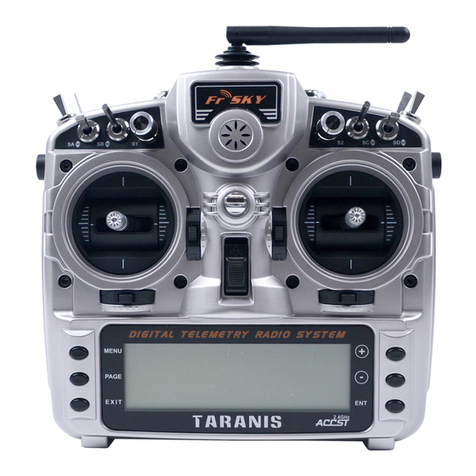
FrSky
FrSky TARANIS X9D User manual

FrSky
FrSky D6FR User manual
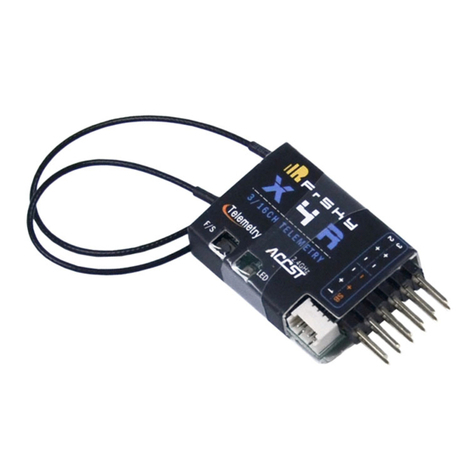
FrSky
FrSky X4R-SB User manual
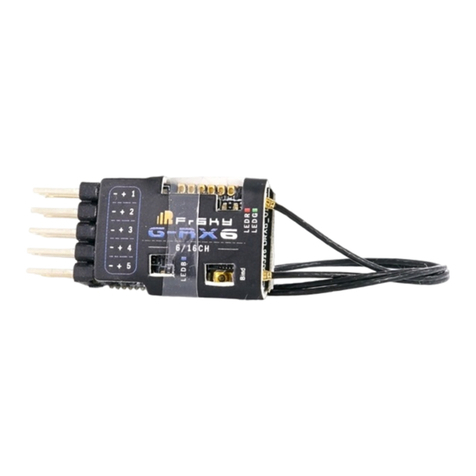
FrSky
FrSky ACCESS G-RX6 User manual
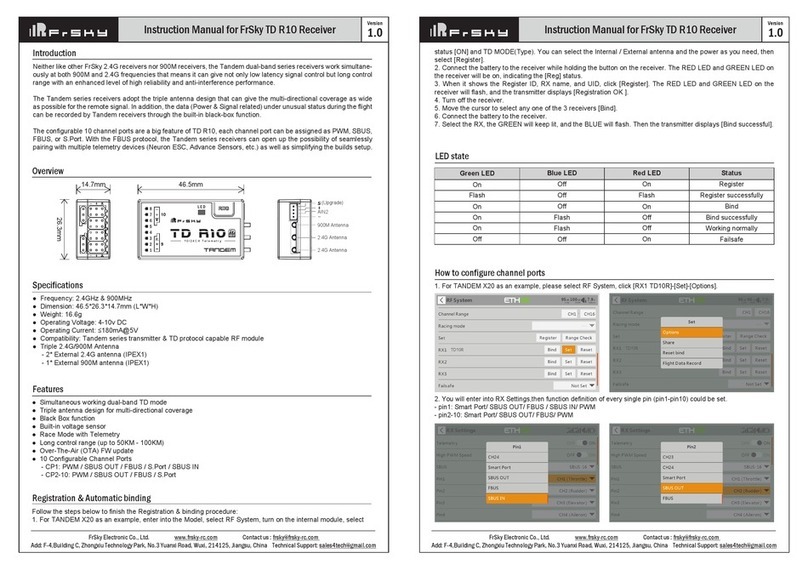
FrSky
FrSky TD R10 User manual
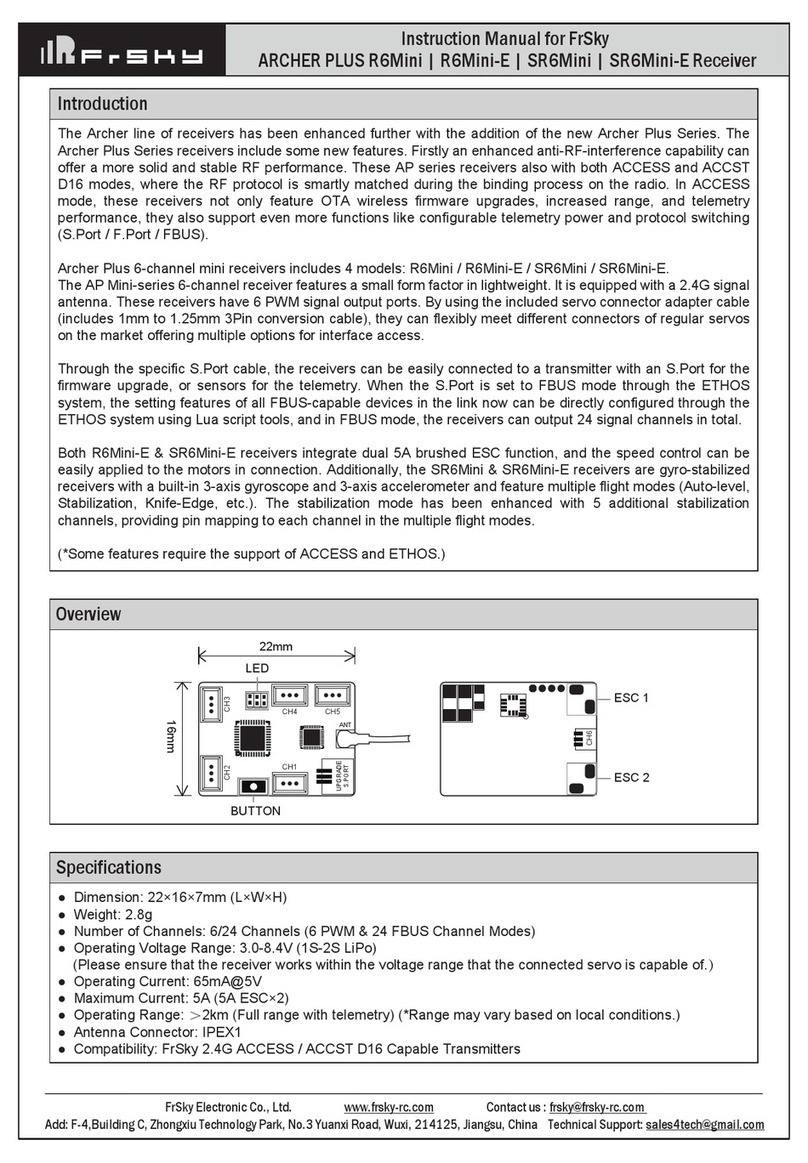
FrSky
FrSky ARCHER PLUS R6Mini User manual

FrSky
FrSky X4R-SB User manual
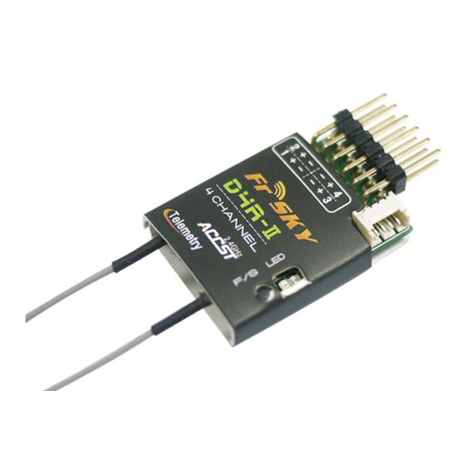
FrSky
FrSky D4R-II User manual
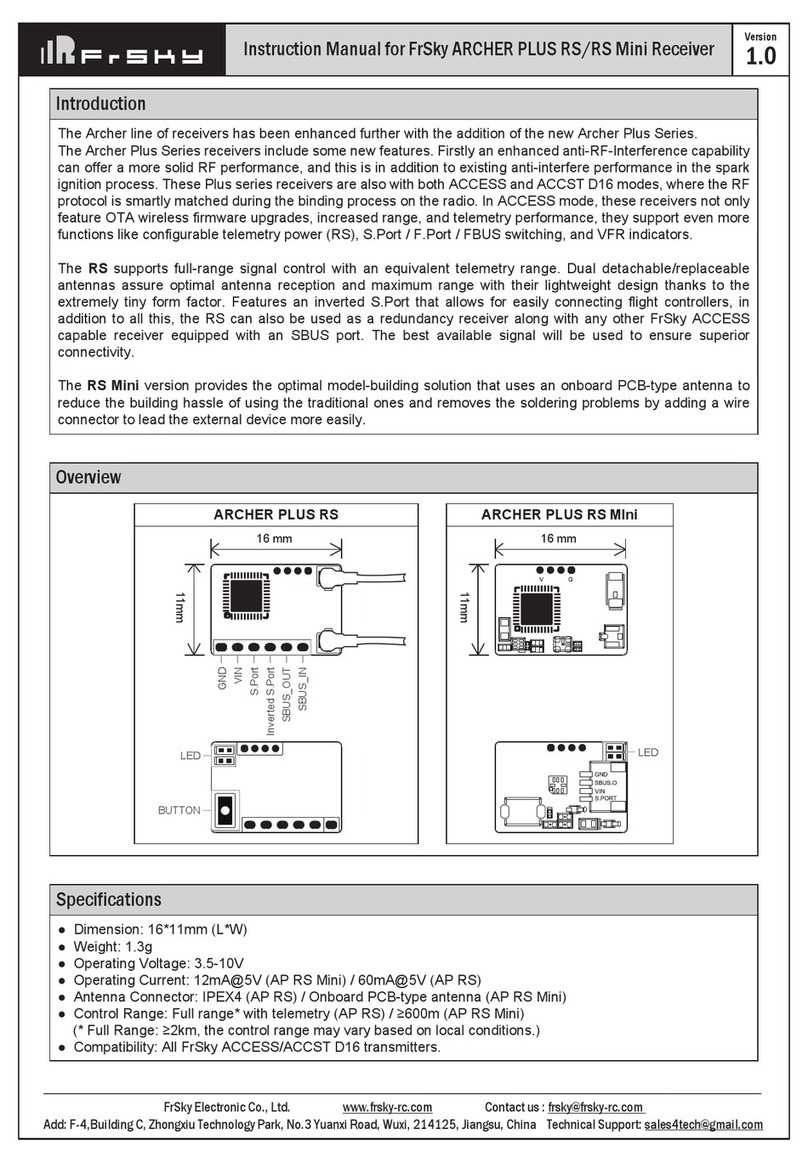
FrSky
FrSky ARCHER PLUS RS User manual
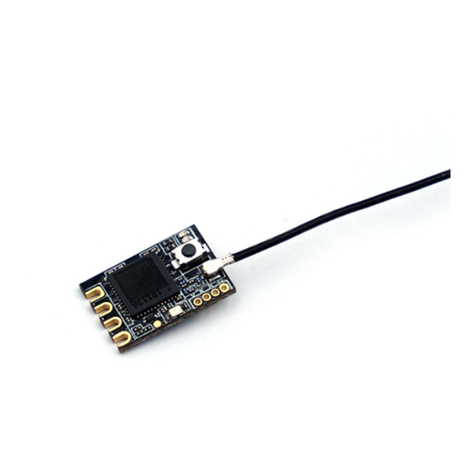
FrSky
FrSky ARCHER M+ User manual
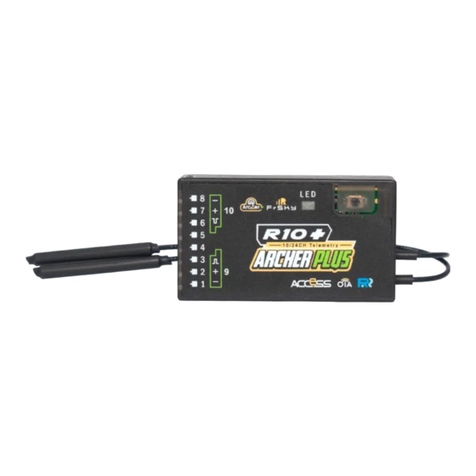
FrSky
FrSky ARCHER PLUS R10+ User manual

FrSky
FrSky HORUS X10 User manual

FrSky
FrSky TARANIS X9D User manual
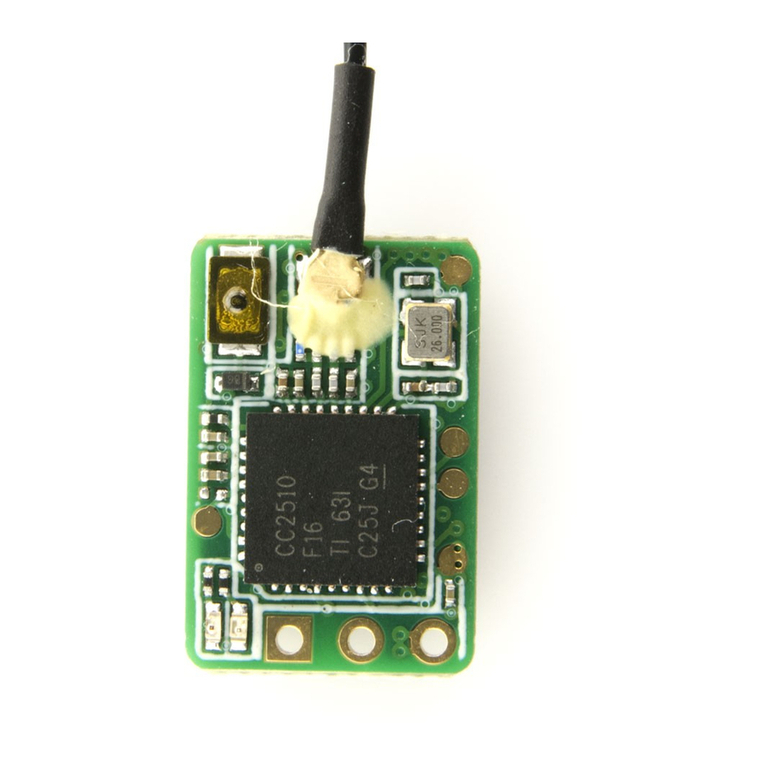
FrSky
FrSky ACCESS XM User manual
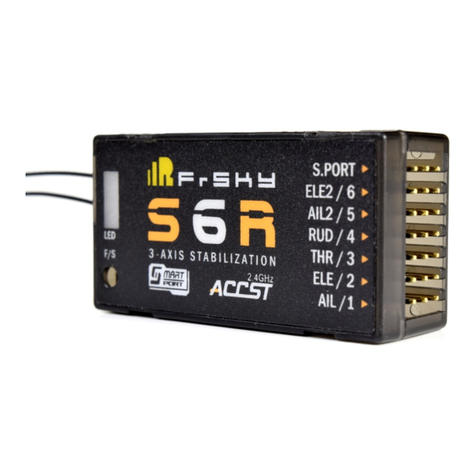
FrSky
FrSky S6R User manual

FrSky
FrSky R9 User manual
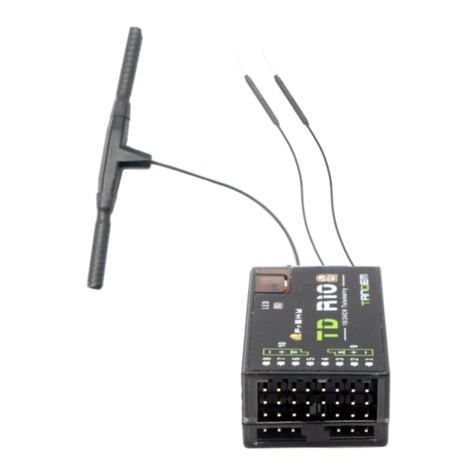
FrSky
FrSky TD R10 User manual

FrSky
FrSky RX6R User manual
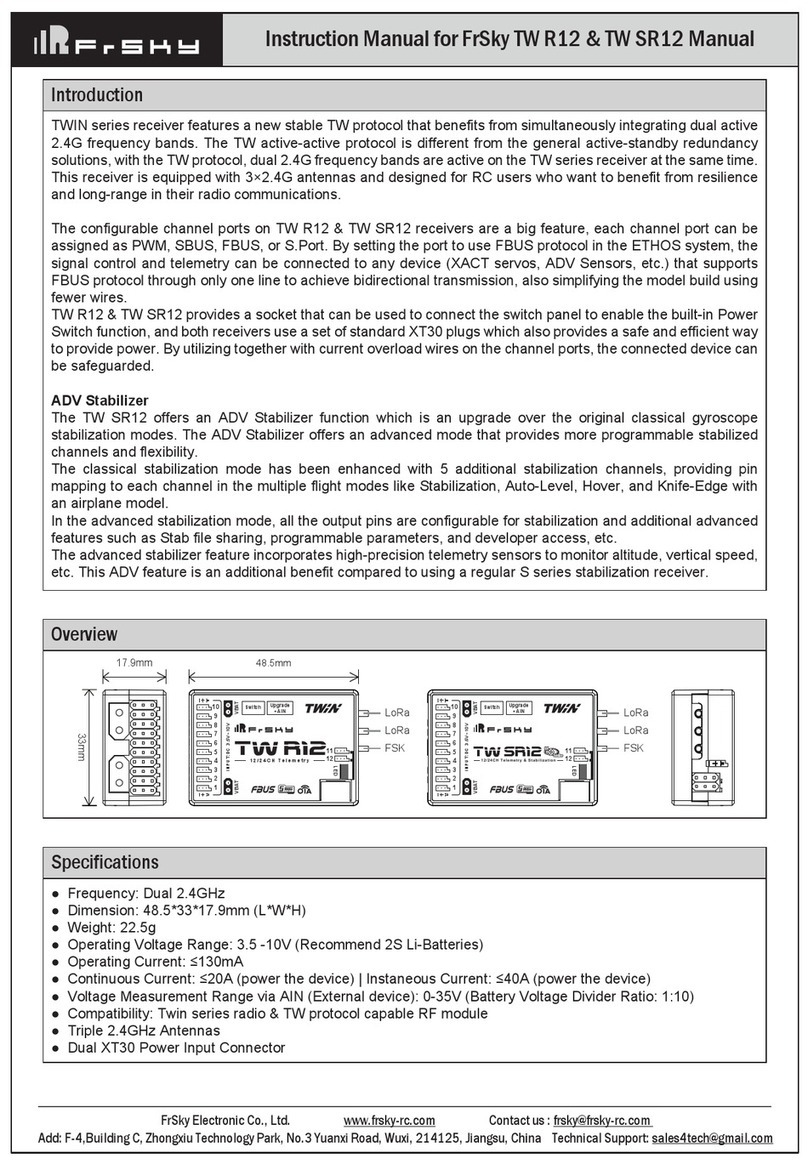
FrSky
FrSky TWIN Series User manual

FrSky
FrSky X4R-SB User manual
